It looks like you're using an Ad Blocker.
Please white-list or disable AboveTopSecret.com in your ad-blocking tool.
Thank you.
Some features of ATS will be disabled while you continue to use an ad-blocker.
share:
It is already popular belief that a mass extinction event at some time in history wiped out a majority of the life on the planet, and there is good
reason to believe it was a global flood. The evidence for this comes from the way that sedimentary rock is formed.
Many know that bricks are formed very quickly by exposing mud mixtures to sunlight. This happens quickly. Pressure is another way in which mud mixtures are turned to stone, also very quickly. Take for example the Temple of Djenne, which is literally sedimentary rock formed by the locals adding mud over the years:
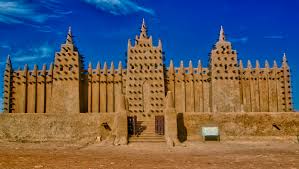
So if mud can turn to stone so quickly, why are the geological layers believed to be so old? It is partly because there are fossilized organisms dispersed throughout these layers. Now think about it, how would fossilized organisms permeate through these geological layers if they grew gradually over millions of years? Consider polystrate fossils, which are tree fossils that literally permeate vertically through these strata, clearly showing the deposition of these geological layers occurred at once:
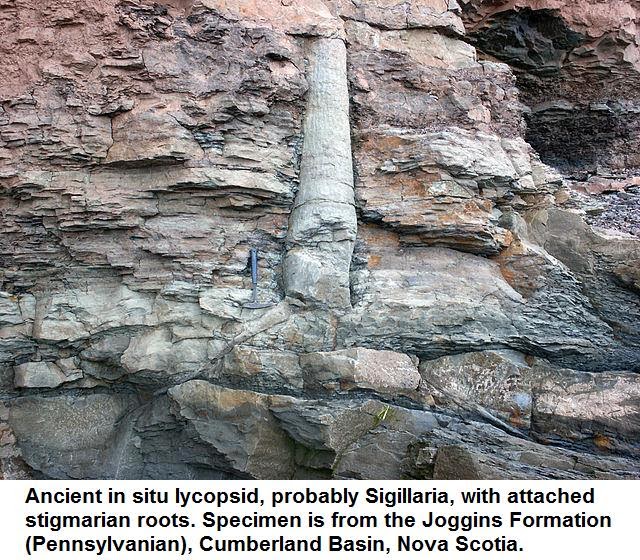
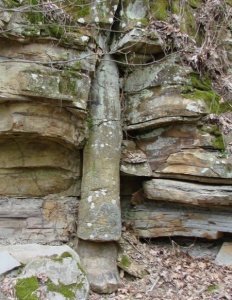
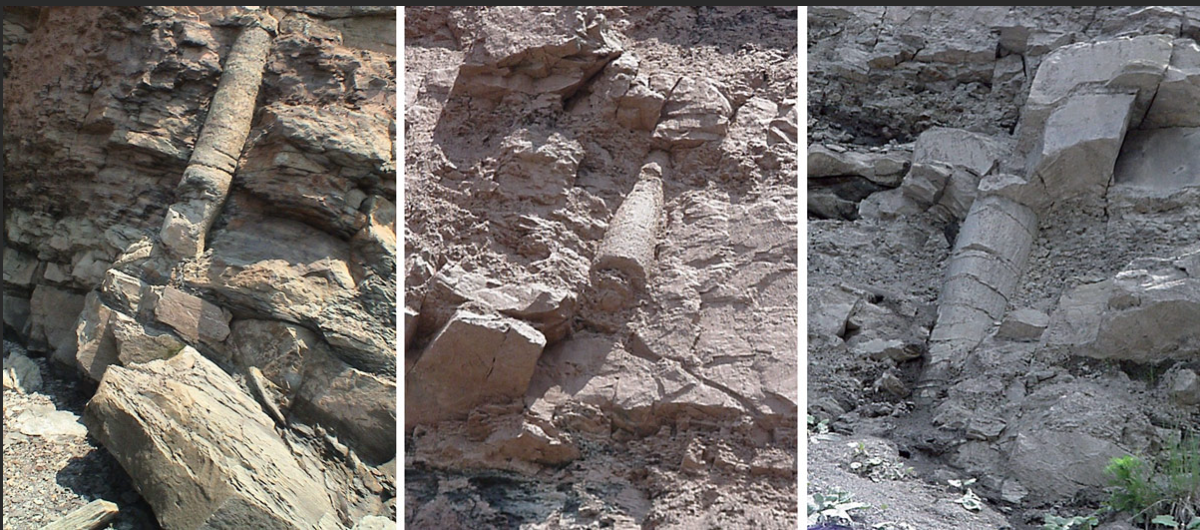
If these layers took millions of years, it would not allow a vertical tree to persist for that long. For this reason, It is clear this was due to a massive flood.
Now imagine the global flood (historical and scientific evidence here), when the flood waters covered the planet, there would be massive amounts of mud being thrown about the surface of the earth underneath the flood waters, coinciding with the various dead organisms thrown about. When the flood waters subsided, these layers would have settled and stratified, mixed with diverse fossils of creatures. Here is a beautiful example of how a muddy slurry will settle into geological strata:

So now what would happen to all the organic matter (dead organisms) dispersed throughout these layers? There would be immense pressure from the sudden formation of these layers once the flood subsided, and this pressure is what essentially acted like a massive oil press on the organic matter intermingled in geological strata. organic Gas (natural gas) pockets also would have gotten trapped beneath the immense layers deposited from the flood, another thing which would not have happened with gradual deposition - how would gas get trapped deep underground if it was a slow million-year process occurring on the surface??? absurd. natural gas is less dense than air, and will float away, it certainly does not sink into these rock layers.

Imagine all the foliage from the pre-flood earth, now in a mud slurry, being hard-pressed to extract the crude oil that is known to exist within these sedimentary rock layers that were once mud! It all fits perfectly.
"A new breakthrough in biofuels production allows researchers to turn living algae into crude oil ready for processing -- and it only takes less than an hour."
link
Notice if you read the link, they attribute it to millions of years, yet they claim it can be done in mere hours with enough pressure. That is how dogmatic the evolutionary narrative has become - even when faced with evidence that crude oil can form quickly, they default to the popular narrative to avoid scrutiny.
Scientists already agree there was a huge extinction event, it is time to admit it was the flood that our ancestors described in their records.
Many know that bricks are formed very quickly by exposing mud mixtures to sunlight. This happens quickly. Pressure is another way in which mud mixtures are turned to stone, also very quickly. Take for example the Temple of Djenne, which is literally sedimentary rock formed by the locals adding mud over the years:

So if mud can turn to stone so quickly, why are the geological layers believed to be so old? It is partly because there are fossilized organisms dispersed throughout these layers. Now think about it, how would fossilized organisms permeate through these geological layers if they grew gradually over millions of years? Consider polystrate fossils, which are tree fossils that literally permeate vertically through these strata, clearly showing the deposition of these geological layers occurred at once:



If these layers took millions of years, it would not allow a vertical tree to persist for that long. For this reason, It is clear this was due to a massive flood.
Now imagine the global flood (historical and scientific evidence here), when the flood waters covered the planet, there would be massive amounts of mud being thrown about the surface of the earth underneath the flood waters, coinciding with the various dead organisms thrown about. When the flood waters subsided, these layers would have settled and stratified, mixed with diverse fossils of creatures. Here is a beautiful example of how a muddy slurry will settle into geological strata:

So now what would happen to all the organic matter (dead organisms) dispersed throughout these layers? There would be immense pressure from the sudden formation of these layers once the flood subsided, and this pressure is what essentially acted like a massive oil press on the organic matter intermingled in geological strata. organic Gas (natural gas) pockets also would have gotten trapped beneath the immense layers deposited from the flood, another thing which would not have happened with gradual deposition - how would gas get trapped deep underground if it was a slow million-year process occurring on the surface??? absurd. natural gas is less dense than air, and will float away, it certainly does not sink into these rock layers.

Imagine all the foliage from the pre-flood earth, now in a mud slurry, being hard-pressed to extract the crude oil that is known to exist within these sedimentary rock layers that were once mud! It all fits perfectly.
"A new breakthrough in biofuels production allows researchers to turn living algae into crude oil ready for processing -- and it only takes less than an hour."
link
Notice if you read the link, they attribute it to millions of years, yet they claim it can be done in mere hours with enough pressure. That is how dogmatic the evolutionary narrative has become - even when faced with evidence that crude oil can form quickly, they default to the popular narrative to avoid scrutiny.
Scientists already agree there was a huge extinction event, it is time to admit it was the flood that our ancestors described in their records.
edit on 16-12-2023 by cooperton because: (no reason given)
a reply to: cooperton
But organic material floats. How did it get under the mud if it was deposited in a general all over flood? It would have settled at or near the top of the mud.Where did the mud come from in the volume needed for this to occured? Were there mountains ten miles high all over the contents before the great flood?
Just asking.
But organic material floats. How did it get under the mud if it was deposited in a general all over flood? It would have settled at or near the top of the mud.Where did the mud come from in the volume needed for this to occured? Were there mountains ten miles high all over the contents before the great flood?
Just asking.
originally posted by: BeyondKnowledge3
a reply to: cooperton
But organic material floats. How did it get under the mud if it was deposited in a general all over flood? It would have settled at or near the top of the mud.Where did the mud come from in the volume needed for this to occured? Were there mountains ten miles high all over the contents before the great flood?
Just asking.
Some times yeah, and I think that would be why there are so many fossils that are so close to the surface. But freshly dead animals don't usually float, it's only once they start to decompose in a certain way that they become buoyant. Also not all wood floats, it depends on density.
But now imagine, for example, the amazon rainforest getting covered in a mile-high layer of mud. There would be tons and tons of organic matter trapped underneath the mud to be pressed into oil. The rooted plants would allow them to maintain relatively stable as new layers are formed above it. I am picturing the old pre-flood surface of the earth becoming the regions where the oil is most prominently formed
edit on 16-12-2023 by
cooperton because: (no reason given)
originally posted by: BeyondKnowledge3
a reply to: cooperton
But organic material floats. How did it get under the mud if it was deposited in a general all over flood? It would have settled at or near the top of the mud.Where did the mud come from in the volume needed for this to occured? Were there mountains ten miles high all over the contents before the great flood?
Just asking.
Mudfloods caused from volcanoes that liquified the earth.
Can easily be attributed to Earth flipping its axis causing huge dispersments of water and land mass.
Why so many wooly mammoths are found buried in mud at the Arctic Circle
originally posted by: Ohanka
What happened to all the flood water then?
I would suppose it went back down where it came from: below the earth's crust.
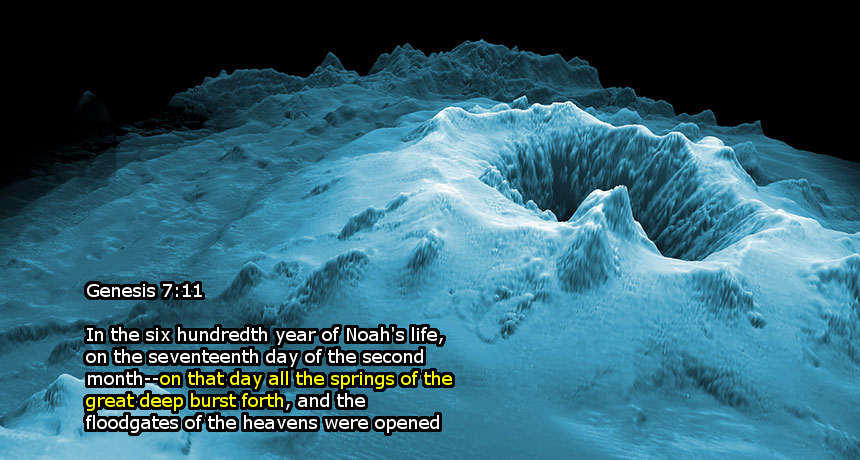
A recent study in 2014 (link) found massive reservoirs of water deep beneath the earth's crust. This reservoir is holding enough water to fill the volume of the earth's oceans 3x over.
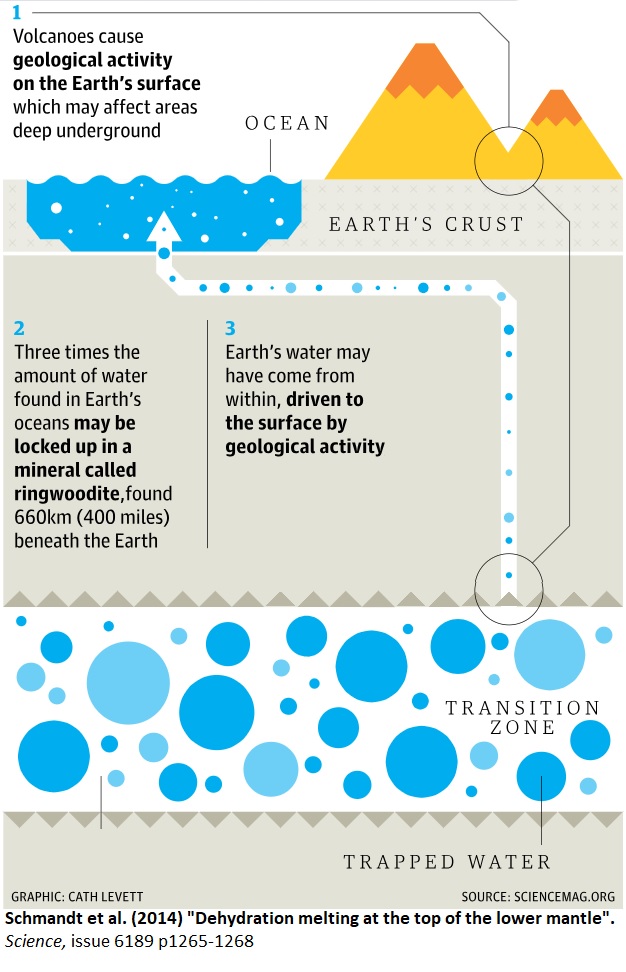
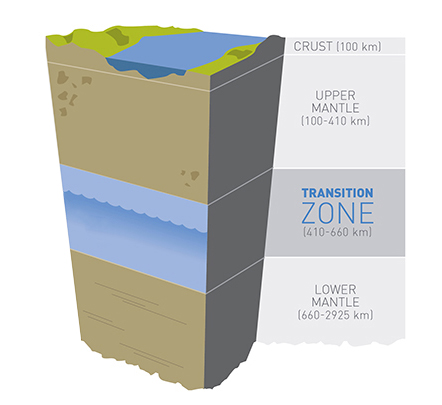
One researcher was quoted saying:
"We should be grateful for this deep reservoir... If it wasn't there, it would be on the surface of the Earth, and mountain tops would be the only land poking out."
originally posted by: cooperton
originally posted by: BeyondKnowledge3
a reply to: cooperton
But organic material floats. How did it get under the mud if it was deposited in a general all over flood? It would have settled at or near the top of the mud.Where did the mud come from in the volume needed for this to occured? Were there mountains ten miles high all over the contents before the great flood?
Just asking.
Some times yeah, and I think that would be why there are so many fossils that are so close to the surface. But freshly dead animals don't usually float, it's only once they start to decompose in a certain way that they become buoyant. Also not all wood floats, it depends on density.
But now imagine, for example, the amazon rainforest getting covered in a mile-high layer of mud. There would be tons and tons of organic matter trapped underneath the mud to be pressed into oil. The rooted plants would allow them to maintain relatively stable as new layers are formed above it. I am picturing the old pre-flood surface of the earth becoming the regions where the oil is most prominently formed
I can imagine the mud covered Amazon Forrest but can't imagine where the mud came from.
originally posted by: BeyondKnowledge3
a reply to: cooperton
But organic material floats. How did it get under the mud if it was deposited in a general all over flood? It would have settled at or near the top of the mud.Where did the mud come from in the volume needed for this to occured? Were there mountains ten miles high all over the contents before the great flood?
Just asking.
After the volcano blew at Mt. St. Helen's there was a landslide that left 600 feet of sediment.
edit on 16-12-2023 by FarmerSimulation because: (no reason given)
originally posted by: BeyondKnowledge3
I can imagine the mud covered Amazon Forrest but can't imagine where the mud came from.
Probably regions that were normally drier and therefore didn't have as many plants, meaning less roots to solidify the soil, allowing it to be more easily swept up by the waters.
It's well known that the more plants there are with deeper roots, the more erosion resistant that environment is. So the wet climates with vast ecosystems like a rainforest would have been well anchored, while dry regions would have been highly vulnerable to their soil being swept away to other areas.
originally posted by: FarmerSimulation
After the volcano blew at Mt. St. Helen's there was a landslide that left 600 feet of sediment.
Nice find. Here's also a video showing just how powerful a flooded river can be:
It's even moving boulders...
Now imagine the whole planet with torrents astronomically stronger than a simple flooded river.
edit on 16-12-2023 by cooperton because: (no
reason given)
originally posted by: FarmerSimulation
originally posted by: BeyondKnowledge3
a reply to: cooperton
But organic material floats. How did it get under the mud if it was deposited in a general all over flood? It would have settled at or near the top of the mud.Where did the mud come from in the volume needed for this to occured? Were there mountains ten miles high all over the contents before the great flood?
Just asking.
After the volcano blew at Mt. St. Helen's there was a landslide that left 600 feet of sediment.
But that only covered a tiny portion of the Earth. Scale matters when you are covering the whole Earth a mile thick.
originally posted by: cooperton
originally posted by: BeyondKnowledge3
I can imagine the mud covered Amazon Forrest but can't imagine where the mud came from.
Probably regions that were normally drier and therefore didn't have as many plants, meaning less roots to solidify the soil, allowing it to be more easily swept up by the waters.
It's well known that the more plants there are with deeper roots, the more erosion resistant that environment is. So the wet climates with vast ecosystems like a rainforest would have been well anchored, while dry regions would have been highly vulnerable to their soil being swept away to other areas.
Tell us you know nothing about plants without telling us you know nothing about plants
You have it backwards. Dryer areas have a plants with deep and vast root systems to get her moisture from the soil and hold it together. A rain forest has little root depth because it is not necessary to make deep roots to gather moisture. They even have plants with no roots in the soil
This is why it is very bad to over water your lawn. The roots remain shallow and because of this cannot survive even a short term drought with water restrictions.
originally posted by: BeyondKnowledge3
originally posted by: FarmerSimulation
originally posted by: BeyondKnowledge3
a reply to: cooperton
But organic material floats. How did it get under the mud if it was deposited in a general all over flood? It would have settled at or near the top of the mud.Where did the mud come from in the volume needed for this to occured? Were there mountains ten miles high all over the contents before the great flood?
Just asking.
After the volcano blew at Mt. St. Helen's there was a landslide that left 600 feet of sediment.
But that only covered a tiny portion of the Earth. Scale matters when you are covering the whole Earth a mile thick.
I only pointed out an isolated case.
If the earth flipped on its axis it would most likely trigger every volcano creating such cataclysm s as to even form the Grand Canyon from debris within huge rivers of liquefied earth in mudfloods.
A lot of interesting geological anomalies transpired from Mt. St. Helen's volcanic fallout and the liquefied Earth.
originally posted by: cooperton
originally posted by: FarmerSimulation
After the volcano blew at Mt. St. Helen's there was a landslide that left 600 feet of sediment.
Nice find. Here's also a video showing just how powerful a flooded river can be:
It's even moving boulders...
Now imagine the whole planet with torrents astronomically stronger than a simple flooded river.
Again, your examples only show local flooding damage. If the water level came up from even rain for 40 days and nights, only the mountains would be affected in that way because the lowlands and coastal areas would already be under water by the time that flooding occured.
originally posted by: BeyondKnowledge3
Again, your examples only show local flooding damage. If the water level came up from even rain for 40 days and nights, only the mountains would be affected in that way because the lowlands and coastal areas would already be under water by the time that flooding occured.
Water levels come up from even rain in local flooding too, and look at the damage it causes. Now imagine on the global scale, it would be exponentially more powerful than just a local flood.
Dryer areas have a plants with deep and vast root systems to get her moisture from the soil and hold it together. A rain forest has little root depth because it is not necessary to make deep roots to gather moisture. They even have plants with no roots in the soil
Good point. I am trying to imagine water rising during the flood, and then gradually falling afterwards. Water 3x more voluminous than the oceans being flushed back into the depths of the earth would certainly have a dramatic effect on landscape. Let's put it this way, mud is definitely moving in mass volumes as the water is going both up and down, total geological chaos. Massive sheets of organic matter getting trapped between sedimentary layers would be inevitable
originally posted by: Ohanka
a reply to: cooperton
How did it all drain back in after 40 days? How come it didn't totally trash the planet (geologically speaking of course) coming to the surface?
Moses landed when the mountaintops were visible, it then would have taken longer for the rest of the water to go down to normal levels. And yeah this process of water rising and then falling over months would have caused massive changes to the earth's surface, thereby creating geological layers. I'm not sure why beyondknowledge3 thinks it would've been a leisurely trip to the bathtub.
edit on 16-12-2023 by cooperton because: (no reason
given)
a reply to: cooperton
Why Cooperton, Why?
This is the thing in armchair academia I am best at, and I will not have you besmirching dykes. I love dykes.
While I am not really disputing what you say, I will insist the existence of dykes does necessarily suggest they formed overnight. Some do. Some are caused by fluid injection, but some are passive, and can be formed in tens of thousands of years.

The fastest forming dykes are actually magmatic (motlen) dykes, or the fluid injected sedimentary ones.
ETA: misread you completely.
Why Cooperton, Why?
This is the thing in armchair academia I am best at, and I will not have you besmirching dykes. I love dykes.
While I am not really disputing what you say, I will insist the existence of dykes does necessarily suggest they formed overnight. Some do. Some are caused by fluid injection, but some are passive, and can be formed in tens of thousands of years.

Clastic dikes (also known as sedimentary dikes) are vertical bodies of sedimentary rock that cut off other rock layers. They can form in two ways:
When shallow unconsolidated sediment is composed of alternating coarse-grained and impermeable clay layers the fluid pressure inside the coarser layers may reach a critical value due to lithostatic overburden. Driven by the fluid pressure the sediment breaks through overlying layers and forms a dike.
When a soil is under permafrost conditions the pore water is totally frozen. When cracks are formed in such rocks, they may fill up with sediments that fall in from above. The result is a vertical body of sediment that cuts through horizontal layers, a dike.
The fastest forming dykes are actually magmatic (motlen) dykes, or the fluid injected sedimentary ones.
ETA: misread you completely.
edit on 16-12-2023 by Degradation33 because: (no reason given)
originally posted by: Degradation33
a reply to: cooperton
Why Cooperton, Why?
This is the thing in academia I am best at, and I will not have you besmirching dykes. I love dykes.
Dykes are a topic of interest for sure !
While I am not really disputing what you say, I will insist the existence of dykes does necessarily suggest the dykes became dykes overnight. Some do. Some are caused by fluid injection, but some are passive, and can be formed in tens of thousands of years.
All 5 images are of dykes. All sedimentary.
"Clastic dikes (also known as sedimentary dikes) are vertical bodies of sedimentary rock that cut off other rock layers. They can form in two ways:
When shallow unconsolidated sediment is composed of alternating coarse-grained and impermeable clay layers the fluid pressure inside the coarser layers may reach a critical value due to lithostatic overburden. Driven by the fluid pressure the sediment breaks through overlying layers and forms a dike.
When a soil is under permafrost conditions the pore water is totally frozen. When cracks are formed in such rocks, they may fill up with sediments that fall in from above. The result is a vertical body of sediment that cuts through horizontal layers, a dike."
The fastest forming dykes are actually magmatic (motlen) dykes, or the fluid injected sedimentary ones.
We have a lot of dykes in California, the ground moves along, and there's a lot of erosion for new grooves to be filled by new dyke formation.
Let me read into this more. But from my initial interpretation, there are a few possibilities with this model I am presenting. There was likely sedimentary rock that persisted through the global flood, and then that sedimentary rock could have its cracks filled with mud from the global flood. Or the global flood created the initial sediment, and then a local flood filled it in later. the magmatic dykes could happen spontaneously whenever there's lava flow near a cavity. I think this would still allow the idea that a global flood created a large portion of our contemporary geological layers.
edit on 16-12-2023 by cooperton because: (no reason given)
a reply to: cooperton
I totally misread you and my eyes suck.
They form almost like sedimentary dykes. They fill a void. Or are entomed by successive layers (like a volcano). Sorry to give you crap. They can form quick in geological terms. And then get buried by more sediment. And then erode away and look trippy.
I totally misread you and my eyes suck.
They form almost like sedimentary dykes. They fill a void. Or are entomed by successive layers (like a volcano). Sorry to give you crap. They can form quick in geological terms. And then get buried by more sediment. And then erode away and look trippy.
In geology, such fossils are referred to as either upright fossil trunks, upright fossil trees, or T0 assemblages. According to mainstream models of sedimentary environments, they are formed by rare to infrequent brief episodes of rapid sedimentation separated by long periods of either slow deposition, nondeposition, or a combination of both.
Upright fossils typically occur in layers associated with an actively subsiding coastal plain or rift basin, or with the accumulation of volcanic material around a periodically erupting stratovolcano. Typically, this period of rapid sedimentation was followed by a period of time - decades to thousands of years long - characterized by very slow or no accumulation of sediments. In river deltas and other coastal-plain settings, rapid sedimentation is often the end result of a brief period of accelerated subsidence of an area of coastal plain relative to sea level caused by salt tectonics, global sea-level rise, growth faulting, continental margin collapse, or some combination of these factors.
edit on 16-12-2023
by Degradation33 because: (no reason given)
originally posted by: Degradation33
a reply to: cooperton
I totally misread you and my eyes suck.
The trees actually grow into the cracks and form almost exactly like sedimentary dykes. Sorry to give you crap.
And then erodes away and looks trippy.
"In geology, such fossils are referred to as either upright fossil trunks, upright fossil trees, or T0 assemblages. According to mainstream models of sedimentary environments, they are formed by rare to infrequent brief episodes of rapid sedimentation separated by long periods of either slow deposition, nondeposition, or a combination of both"
As long as it's good-intended critique I don't mind at all. Yeah isn't it wild those are upright trees. They do look like smooth dykes now that you mention it though. I was thinking of hunting for some nearby because I read about a lot of examples in the Appalachian mountains. Would love to get a sample of one. The erratic boulders are all over here too. It's hard for me to get through a hike without wondering about the origins of all these things.
I like the idea that the Bible puts forth because it insists we are children of this super-consciousness that has a plan for the perpetuity of our existence into the deep frontiers of the mind. Evolutionary narrative implies we're just mutated fish that return to oblivion. I am admittedly biased to the former being true, and am happy to have found what I believe is enough evidence to confirm it to be true.
new topics
-
Tariffs all around, Except for ...
Predictions & Prophecies: 33 minutes ago -
Gen Flynn's Sister and her cohort blow the whistle on DHS/CBP involvement in child trafficking.
Whistle Blowers and Leaked Documents: 5 hours ago -
Anybody else using Pomodoro time management technique?
General Chit Chat: 7 hours ago -
Bucks County commissioners vote to count illegal ballots in Pennsylvania recount
2024 Elections: 10 hours ago -
Trump sues media outlets -- 10 Billion Dollar lawsuit
US Political Madness: 11 hours ago -
Fired fema employee speaks.
US Political Madness: 11 hours ago
top topics
-
Trump sues media outlets -- 10 Billion Dollar lawsuit
US Political Madness: 11 hours ago, 24 flags -
Bucks County commissioners vote to count illegal ballots in Pennsylvania recount
2024 Elections: 10 hours ago, 21 flags -
How long till it starts
US Political Madness: 12 hours ago, 17 flags -
USSS Agent Fired for Having Sex In Michelle Obama's Bathroom
Politicians & People: 14 hours ago, 10 flags -
Fired fema employee speaks.
US Political Madness: 11 hours ago, 10 flags -
Watching TV
Jokes, Puns, & Pranks: 17 hours ago, 9 flags -
Gen Flynn's Sister and her cohort blow the whistle on DHS/CBP involvement in child trafficking.
Whistle Blowers and Leaked Documents: 5 hours ago, 7 flags -
Anybody else using Pomodoro time management technique?
General Chit Chat: 7 hours ago, 3 flags -
Tariffs all around, Except for ...
Predictions & Prophecies: 33 minutes ago, 0 flags
active topics
-
Tariffs all around, Except for ...
Predictions & Prophecies • 1 • : tamusan -
President-Elect DONALD TRUMP's 2nd-Term Administration Takes Shape.
Political Ideology • 204 • : WeMustCare -
Mike Tyson returns 11-15-24
World Sports • 49 • : underpass61 -
Bucks County commissioners vote to count illegal ballots in Pennsylvania recount
2024 Elections • 19 • : theatreboy -
How long till it starts
US Political Madness • 17 • : WeMustCare -
USSS Agent Fired for Having Sex In Michelle Obama's Bathroom
Politicians & People • 24 • : rickymouse -
The Acronym Game .. Pt.4
General Chit Chat • 962 • : FullHeathen -
TRUMP Could Be Our Modern Day MOSES - The Similarities are Striking.
ATS Skunk Works • 246 • : WeMustCare -
Anybody else using Pomodoro time management technique?
General Chit Chat • 7 • : tamusan -
The Trump effect 6 days after 2024 election
2024 Elections • 141 • : cherokeetroy
